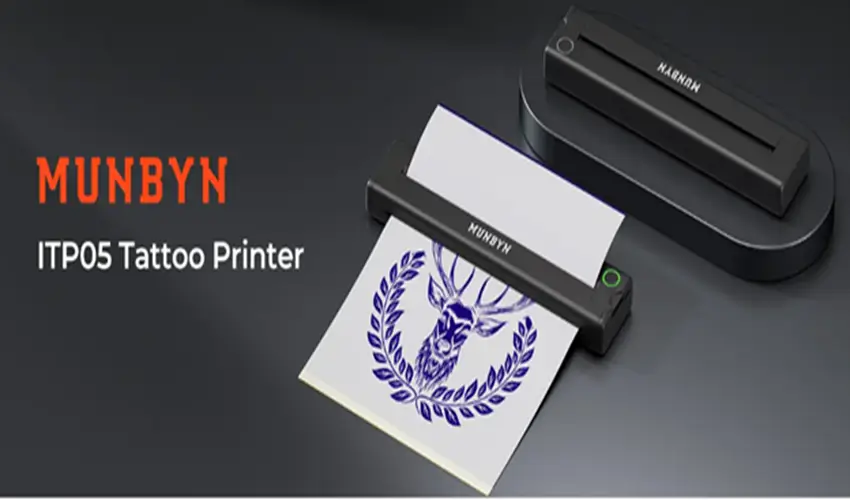
How a Tattoo Stencil Printer Improves Precision and Workflow for Modern Artists
Tattooing is both an art and a technical skill that requires incredible precision, planning, and attention to detail. One of the most critical steps in the process is creating a clear and accurate stencil that serves as a guide for the final tattoo. Traditionally, artists have relied on hand-tracing designs onto stencil paper. While effective, this method can be time-consuming and inconsistent—especially for detailed or complex artwork.
Today, many artists are turning to more efficient tools like a tattoo stencil printer to streamline this essential part of their workflow. These printers are changing how artists prepare their designs, helping them work faster while maintaining accuracy and quality.
What is a Tattoo Stencil Printer?
A tattoo stencil printer is a device specifically designed to print tattoo outlines onto transfer paper. Rather than manually tracing a design with carbon sheets or freehand, artists can now send a digital design to the printer, which then creates a precise stencil. These devices often use thermal or dot-matrix technology to generate clean, crisp lines that transfer well onto the skin.
Modern tattoo stencil printers are portable, often Bluetooth-enabled, and compatible with smartphones, tablets, and laptops. This allows for flexible use in studios, at events, or even on the go. A practical example is this tattoo stencil printer, which caters to artists looking for efficiency and portability in their day-to-day work.
Why Stencils Matter in Tattooing
Creating a stencil is not just a preliminary step—it’s a foundational part of the tattooing process. A well-made stencil ensures that the design is accurately placed on the body, helping guide linework, shading, and overall composition. For complex pieces or symmetrical designs, even a slight variation can affect the final outcome.
Manual tracing, while traditional, can sometimes introduce inconsistencies. Artists might slightly misaligned parts of a design or distort proportions. This can lead to corrections during the tattooing process, adding stress and potentially compromising the quality of the work. A tattoo stencil printer reduces such risks by offering uniformity every time.
The Benefits of Using a Tattoo Stencil Printer
1. Time-Saving Efficiency
Hand-tracing a design can take anywhere from a few minutes to over an hour, depending on complexity. With a stencil printer, this task is reduced to just a few seconds. Artists can simply load their digital design, select the desired print size, and produce a stencil ready for transfer. This allows more time for actual tattooing and less time spent on preparation.
2. Improved Accuracy and Consistency
Even the steadiest hand can make a mistake, especially after long hours or during a busy day. A tattoo stencil printer delivers a high level of precision that helps preserve the proportions, spacing, and overall integrity of the original design. It ensures that every stencil of a particular design is identical—especially important for repeated designs or flash tattoos.
3. Portability for On-the-Go Artists
For tattoo artists who attend conventions, offer home visits, or work in mobile setups, portability is essential. Most modern printers are compact and lightweight, making them easy to transport. A Bluetooth-enabled tattoo stencil printer adds another layer of convenience, allowing artists to print directly from their phones or tablets without the need for wires or large equipment.
4. Professional Workflow and Presentation
Using a stencil printer also enhances the professional image of a tattoo studio or independent artist. Clients appreciate a smooth, modern process—especially when they see their design quickly transformed into a clean stencil. It adds confidence in the artist’s abilities and in the technology supporting the procedure.
Practical Uses Beyond Tattoo Studios
While the primary use of a tattoo stencil printer is within the professional tattooing world, its usefulness extends to other areas:
- Tattoo Training Schools: Instructors can use stencil printers to help students focus on technical skills rather than stencil preparation, which is especially helpful during the learning phase.
- Temporary Tattoo Services: Event-based or promotional temporary tattoo services can use stencil printers to handle large crowds and repeated designs efficiently.
- Cosmetic Tattooing: In procedures like microblading or medical tattooing, where precision is critical, stencil printers help achieve symmetrical and well-placed results.
What to Keep in Mind
While tattoo stencil printers offer many benefits, they also require some planning:
- Design Preparation: Designs must be prepared digitally, usually in high-contrast black and white formats. Artists may need basic graphic editing skills to adjust or resize their work for optimal stencil printing.
- Supply Compatibility: Not all printers are compatible with every type of transfer paper. It’s important to use the right materials to avoid issues with print quality or skin transfer.
- Battery Life: For portable models, battery life can vary. Keeping the device charged, especially before mobile sessions or events, ensures uninterrupted use.
Final Words
As technology continues to evolve, tools like the tattoo stencil printer are becoming essential assets for modern tattoo artists. By automating one of the most crucial parts of the tattooing process, these printers enhance precision, speed up workflow, and reduce the chances of human error.Whether you’re a seasoned professional or an artist just starting out, adopting a stencil printer can significantly elevate your tattooing process.



